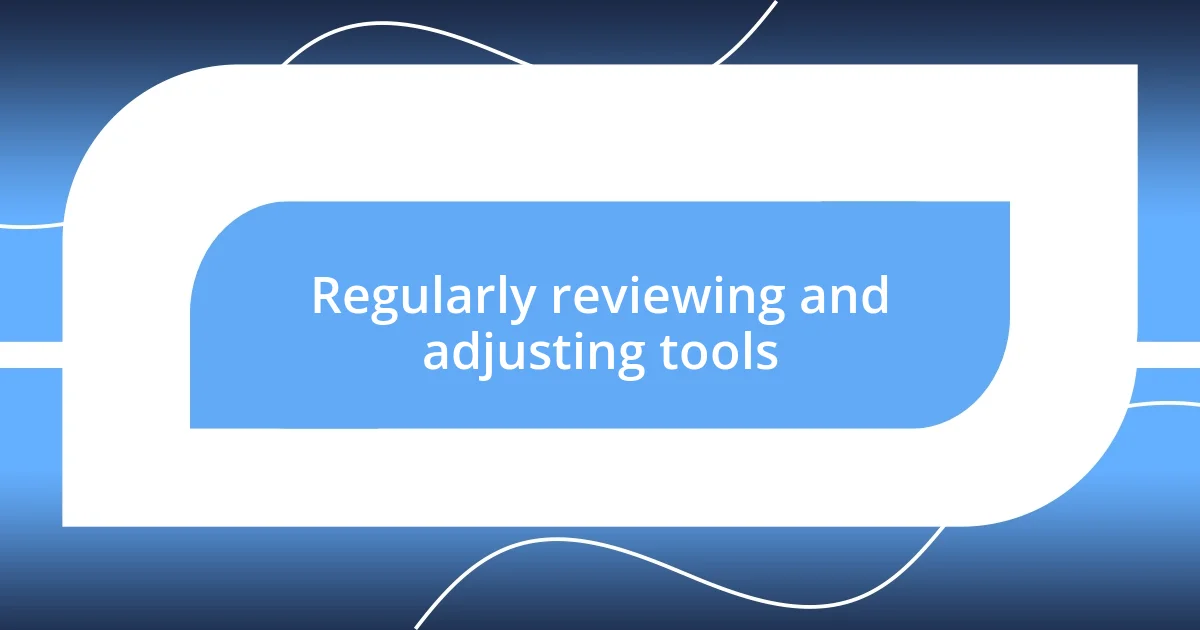Key takeaways:
- Choosing the right productivity tools involves identifying personal needs, trial and error, and ensuring user-friendly experiences to enhance workflow.
- Setting SMART goals and regularly reviewing them can sharpen focus and boost motivation by breaking tasks into manageable parts.
- Sharing insights and practices with others can foster growth and innovation, leading to new techniques and revitalized approaches to productivity.

Understanding productivity tools
Productivity tools are designed to streamline tasks and enhance efficiency, but have you ever stopped to think about what that truly means for you? For instance, I remember when I first started using a task management app—initially, it felt overwhelming, but over time, it turned my chaotic to-do list into a well-organized game plan. Seeing my tasks visually laid out changed how I approached my day; it was like switching on a light in a formerly dim room.
At their core, these tools are meant to alleviate stress and foster flow, but individuality plays a huge role in their effectiveness. It took me a while to discover that not every tool suits every personality. What works wonders for one person might feel suffocating for another. Think about it: have you ever tried a new tool only to realize it just added to your anxiety instead of easing it? I have, and it taught me to experiment until I found what resonates with me.
Moreover, understanding how to leverage these tools culminates in a more personalized approach to productivity. I vividly recall the first time I integrated a calendar syncing feature with my task manager; it felt like a major breakthrough. The clarity it brought allowed me to prioritize and allocate my time more effectively. Really, it’s about finding the right balance and harnessing technology in a way that complements your workflow, don’t you think?

Choosing the right tools
Choosing the right tools can be a game changer for productivity, but it’s essential to take a thoughtful approach. I once invested time in several high-rated apps, only to realize that many of them overwhelmed me instead of simplifying my workflow. It’s crucial to reflect on what features you truly need rather than getting swayed by trends or recommendations from others.
Here are some key points to consider when selecting productivity tools:
- Identify Your Needs: Think about the specific tasks you want to streamline. Do you need a tool for time management, collaboration, or task tracking?
- Trial and Error: Don’t hesitate to try multiple tools. I often find that testing several options helps me discover what aligns best with my workflow.
- Integration Capabilities: Look for tools that can integrate with what you already use. Finding a tool that syncs with your existing systems can save you time and frustration.
- User Experience: Prioritize tools that are intuitive and enjoyable to use. If I find myself dreading to open an app, it’s a cue that it’s not the right fit for me.
- Feedback and Reviews: Listening to experiences from others can provide insight into whether a tool might suit you, but remember to balance this with your personal preferences.

Setting clear productivity goals
Setting clear productivity goals allows me to focus my efforts and track my progress effectively. I’ve learned that without well-defined goals, my productivity tends to drift. In my experience, setting SMART goals—Specific, Measurable, Achievable, Relevant, and Time-bound—provides clarity and direction. It’s like using a compass when you’re setting off on a journey; it helps you avoid getting lost in a sea of tasks.
Another important aspect is to break down larger goals into smaller, manageable tasks. I remember the first time I set a big project deadline; it felt overwhelming until I broke it down into weekly and daily tasks. Suddenly, I could see progress and celebrate small victories, which boosted my motivation. Have you tried this approach yourself? It really makes a difference in how I perceive and approach my workload.
Additionally, regularly reviewing and adjusting my goals has proven invaluable. I like to set aside time each week to assess what I’ve accomplished and what needs re-evaluation. This reflection helps me stay aligned with my priorities and adapt to any changes that come my way. I can’t stress enough how this practice has sharpened my focus and increased my overall productivity.
| Goal Characteristics | Example |
|---|---|
| Specific | Increase daily writing time |
| Measurable | Write 500 words per day |
| Achievable | Set aside 30 minutes daily |
| Relevant | Write blog content for website |
| Time-bound | Complete by end of the month |

Integrating tools into workflows
Integrating tools into my workflow is where the real magic happens. When I first started using project management software, it felt clunky and overwhelming. But once I dedicated some time to tailor it to my needs—like creating custom dashboards and setting reminders—I saw a significant boost in my efficiency. How do you feel about customizing tools? I believe it’s a crucial step toward making them truly work for you.
Finding ways to connect different tools can also enhance your workflow significantly. I remember struggling to keep track of tasks across various platforms. Then, I discovered automation tools that allowed me to sync my task manager with my calendar. Now, I spend less time switching between apps and more time focusing on what truly matters. Have you ever tried automating mundane tasks? The relief can be transformative.
Lastly, continuous evaluation of how well tools fit into my workflow has proven essential. Periodically, I set aside some time—maybe a monthly check-in—to assess whether a tool still meets my evolving needs. I once kept an app that I eventually realized was no longer beneficial, simply out of habit. When I let it go, it was like shedding a weight I didn’t know I was carrying. Isn’t it freeing to streamline your toolkit as your work evolves?

Monitoring progress and efficiency
Monitoring my progress and efficiency has become a key component in my productivity journey. I often use tracking tools to visualize what I’ve accomplished over the week. There’s something satisfying about seeing those little boxes checked off or metrics improving—it fuels my motivation. Have you experienced that rush when you realize your hard work is paying off?
One technique I’ve found particularly effective is the use of digital time trackers. At first, I was skeptical about whether logging my hours would feel tedious, but it transformed how I viewed my work. After tracking my time for a couple of weeks, I noticed patterns in my productivity that I hadn’t recognized before. For instance, I realized that my most concentrated work often happened in the morning. Wouldn’t it be great to optimize your work hours based on personal insights like that?
I also believe in having regular check-ins with myself, where I pause to reflect on my progress. I recall a time when I felt lost in a project, overwhelmed by all I had to do. After a quick self-assessment, I recognized that I was veering off-course. This reflection not only recalibrated my focus but also alleviated a lot of stress. Have you ever needed a moment to step back and see the bigger picture? Sometimes, it’s that simple act of pausing that brings clarity and direction.

Regularly reviewing and adjusting tools
Regularly reviewing and adjusting my productivity tools is like fine-tuning a musical instrument; it ensures everything plays harmoniously. I often schedule a specific time, usually at the end of the month, to evaluate which tools still serve my purposes. I remember a software I kept using long after it had become obsolete for my needs. When I finally let it go—replacing it with a more streamlined option—I felt a wave of relief wash over me. Have you ever held onto a tool for too long simply out of familiarity?
Adjustments aren’t just necessary; they’re exciting! When I discover a new feature or an alternative tool that could simplify my workflow, it feels like finding hidden treasure. For instance, I recently switched to a different project management app that integrated seamlessly with my existing tools, cutting my daily task setup time in half. It’s incredible how even small updates can revamp my daily routine—have you ever experienced that spark of innovation that completely reinvigorates your approach?
Lastly, I like to check in with colleagues about the tools they use. Sharing insights opens up a door to possibilities I might not have considered. Just the other week, a friend shared a nifty chatbot method that automated her routine updates, which I initially thought would require a steep learning curve. Yet, after trying it out, I found it not only user-friendly but also a game-changer in my communication flow. Isn’t it amazing how collaboration can lead to those “aha!” moments?

Sharing insights and best practices
Sharing insights and best practices is one of the most rewarding aspects of utilizing productivity tools. Recently, during a coffee chat with a friend, I learned about a technique called the “Pomodoro Technique.” It involves breaking work into intervals, traditionally 25 minutes, followed by a short break. I was pleasantly surprised by how focusing my efforts in such blocks not only maintained my energy levels but also led to a noticeable increase in my output. Have you ever felt that a simple shift in approach can unlock your potential?
I also emphasize the value of documenting my productivity journeys. I love jotting down key takeaways in a personal journal after implementing new tools. For instance, I once began using a digital note app that allowed me to categorize and tag entries. The organization it brought to my thoughts was refreshing. Looking back, I realize how those notes served as a treasure trove of strategies I could revisit whenever I hit a snag. Isn’t it fascinating how reflecting on past experiences can inspire fresh ideas?
Moreover, I’ve found that sharing my successes and failures on social media or in small groups helps reinforce my learning. I remember posting about my struggles with time management and receiving an outpouring of helpful tips and encouragement. This communal exchange of insights not only built my network but also infused me with renewed energy. Have you explored how sharing your experiences could strengthen your productive habits? It’s remarkable what a little vulnerability can do in promoting growth!














